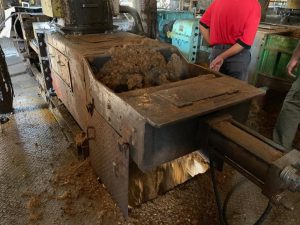
August 15, 2019, by Communications
Final year research project: Educational visit to palm oil mill industry
This blog post is a recount of final year students: Nurul Asyikin Mohd Najib, Farah Amira Mohammad Lanan, Isabelle Tay Sui Kim, Khoo Miinyi, Vasanthi Sethu, Anurita Selvarajoo and Senthil Kumar Arumugasamy on their final year research project.

From left: Farah Amira binti Mohammad Lanan, Isabelle Tay Sui Kim, Nurul Asyikin Binti Mohd Najib and Khoo Miinyi.
In recent years, the palm oil plantation has expanded its area up to 1.3 % and reached up to 5.81 million hectares, putting Malaysia as the second-largest exporter in the world. Therefore, for a sustainable and green palm oil industry, treatment of palm oil mill effluent (POME) has become a vital issue due to its high acidity, turbidity, total suspended solids (TSS) and chemical oxygen demand (COD). Solutions to treat POME are required to comply with discharge requirement, minimize water pollution and prevent deleterious environmental impacts.
The proposed project was “Preparation and Evaluation of Novel Plant-Based Coagulant-Flocculant for the Treatment of POME”. This is because natural plant-based coagulant and flocculant display many advantages over chemical agents is predominantly non-toxic, biodegradable, low-cost and generates less residual in sludge production.
This project has led to the opportunity of visiting a local palm oil mill in Banting, Selangor, Malaysia to collect fresh POME samples for the research project. On the 11th of February 2019, a site visit was carried out by a team of four final year students in the chemical and environmental engineering department from the University of Nottingham Malaysia. From the moment of arrival, we were greeted by the company’s representative followed by a short introduction on the safety requirement. Then, he drove us to the treatment pond sites for POME collection. There were a total of 8 treatment ponds of equal size. The first thing that came to mind when we arrived was the unbearable distinct odour in which the representative told us the odour would stay on throughout the day. Additionally, we felt the heat emitting from the ponds and linked it with the uncontrolled emission of methane and carbon dioxide that has the potential to as biogas.
After that, a detailed and comprehensive tour of the facility and a first-hand introduction to the extraction process of crude palm oil were conducted by the representative. The odour was faint if compared with the treatment ponds but it was much hotter, especially during sterilization of the fruit bunches and digestion of the fruit.
The palm oil milling process involves the extraction of palm products namely crude palm oil and palm kernel from the fruit bunches. The oil palm produces 2 types of oils which are palm oil from fibrous mesocarp and lauric oil from palm kernel. The milling process starts with sterilisation of fruit bunches followed by the stripping of fruitlet in a rotating drum thresher. The fruitlets obtained are digested and pressed to extract the crude palm oil (CPO) and obtain the press cake. The nuts are separated from the press cake and are cracked to obtain the palm oil kernel. The kernels are then crushed to obtain the crude palm kernel oil (CPKO) and by-product, palm kernel cake. POME is generated from the extraction of oil from the seeds, cleaning of equipment and condensed steam after the sterilization process and is treated via a ponding system of sequential anaerobic, aerobic and facultative ponds.
The empty fruit bunches (EFB) after threshing and recovered kernels and mesocarp fibres are composted to be reused as fertilizers in the plantation or as a side-product, rather than being sold directly as they are. The organic wastes were arranged into long windrows, inoculated with microbes and then dosed with small quantities of urea to kickstart the microbial process. Microbe-rich sludge settled at the bottom of POME treatment tanks is pumped and sprinkled onto the compost pile. This process releases heat, steam, methane and hydrogen sulphide gases; both gases being responsible for the odour encountered within the entire plant.
In conclusion, the treatment ponds contribute to a large carbon footprint while the uncontrolled emissions of methane and carbon dioxide lead to the increase of greenhouse gases (GHGs) that contribute to climate change. However, the choice of open ponding system is still a conventional method for treating POME due to its low cost. As for the palm oil mill process, it generates a lot of heat which could be inefficient due to the loss of thermal energy. Overall, it was an educational and beneficial experience as no amount of researching or book learning could convey the situational conditions at the palm oil mill.

Back row (from left): Nurul Asyikin binti Mohd Najib, Khoo Miinyi, Farah Amira binti Mohammad Lanan, Isabelle Tay Sui Kim, Dr Anurita Selvarajoo (UNM lecturer). Front row (from left): Mr. Prasad (manager), Mr. Balakrishnan (mill manager).
- Palm oil boiler operated under 100 celcius
- Collection of POME samples at the first discharge point
- A row of palm oil digester to crush sterilized palm fruits to fruit pulp in palm oil production
- Sterialisation station of FFB with process steam supplying heat
- a row of bin collection of fresh fruit bunch (FFB)
-
Post a comment






